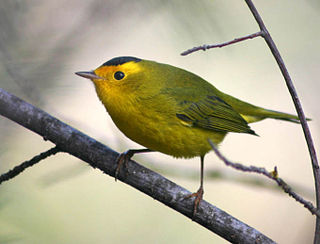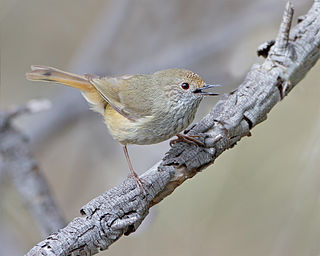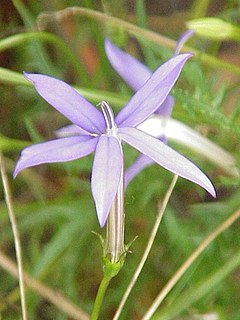
Baillon's crake, also known as the marsh crake, is a small waterbird of the family Rallidae.

Wilson's warbler is a small New World warbler. It is greenish above and yellow below, with rounded wings and a long, slim tail. The male has a black crown patch; depending on the subspecies, that mark is reduced or absent in the female. It breeds across Canada and south through the western United States, and winters from Mexico south through much of Central America. It is a very rare vagrant to western Europe.

The Senegal eremomela is a member of the African warbler family, the Cisticolidae. It occurs in the savannas of western Sub-Saharan Africa.

Casuarina is a genus of 17 tree species in the family Casuarinaceae, native to Australia, the Indian subcontinent, southeast Asia, islands of the western Pacific Ocean, and eastern Africa. It was once treated as the sole genus in the family, but has since been split into four genera.

The brown thornbill is a passerine bird usually found in eastern and south-eastern Australia, including Tasmania. It can grow up to 10 cm (3.9 in) long, and feeds on insects. It is brown, grey and white. The species has five subspecies.

Isotoma is a genus of annual and perennial herbs in the family Campanulaceae and are native to Australia and New Zealand.

The little lorikeet is a species of parrot in the family Psittaculidae. It is endemic to Australia. It is a small parrot, predominantly green in plumage with a red face. Its natural habitats are subtropical or tropical dry forest and subtropical or tropical moist lowland forest.

Isotoma axillaris, commonly known as rock isotome or showy isotome, is a small herbaceous perennial in the family Campanulaceae. It usually has blue or mauve star-shaped flowers from September to May. It may also be called blue star, star flower, or laurentia.
Eucalyptus subangusta is a species of tree, mallee or mallet that is endemic to the southwest of Western Australia. It has smooth bark, narrow lance-shaped leaves, flower buds in groups of up to nineteen, white flowers and cup-shaped to barrel-shaped fruit.

Acacia pusilla is a shrub of the genus Acacia and the subgenus Phyllodineae the is endemic to south western Australia.
Acacia rhamphophylla, commonly known as Kundip wattle, is a shrub of the genus Acacia and the subgenus Phyllodineae that is endemic to a small area in south western Australia. It is listed as an endangered species according to the Environment Protection and Biodiversity Conservation Act 1999.

Hakea pycnoneura is a shrub in the family Proteaceae. It has fragrant, pink-purplish flowers in the leaf axils. It is endemic to a small area on the west coast in the Mid West and a smaller area on the south coast in the Goldfields-Esperance regions of Western Australia.

Isotoma hypocrateriformis, commonly known as Woodbridge poison, is a small herbaceous perennial in the family Campanulaceae native to Western Australia.
Isotoma luticola is a small herbaceous plant in the family Campanulaceae native to Western Australia.

Isotoma petraea, commonly known as rock isotome, is a small, herbaceous plant in the family Campanulaceae occurring in arid regions of Australia. It has single, purplish-blue flowers on smooth, slender branches from February to November.

Isotoma scapigera, commonly known as long-scaped isotome, is a small herbaceous plant in the family Campanulaceae native to Western Australia.

Isotoma fluviatilis, the swamp isotome or blue star creeper, is a small herbaceous perennial plant in the family Campanulaceae, native to Australia.

Isotoma anethifolia is a small herbaceous plant in the family Campanulaceae and is endemic to eastern Australia. It has single, mostly white flowers in the leaf axils and slender stems.
Eleocharis pusilla is a sedge of the family Cyperaceae that is native to Australia.

Goodenia pusilla is a species of flowering plant in the family Goodeniaceae and is endemic to the southwest of Western Australia. It is an ascending herb with lance-shaped to egg-shaped leaves at the base of the plant and single yellow flowers with brownish markings.
















